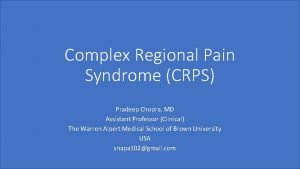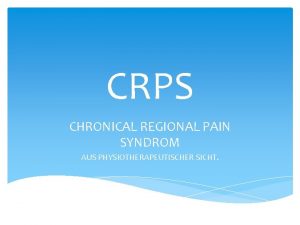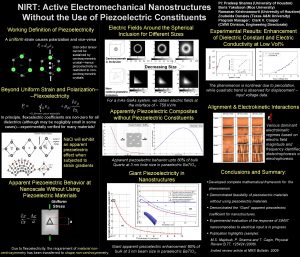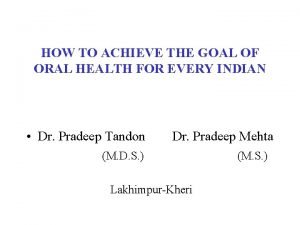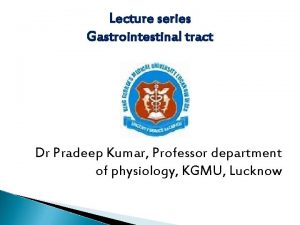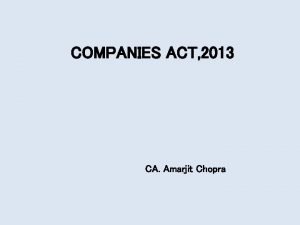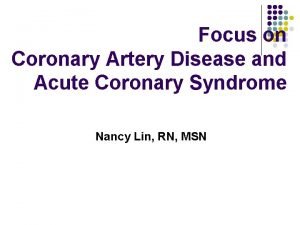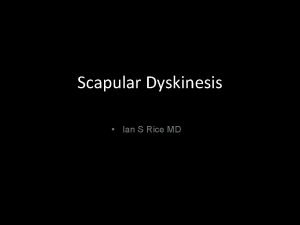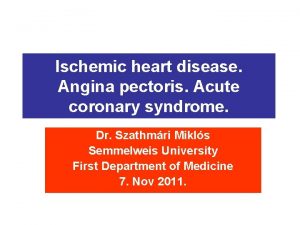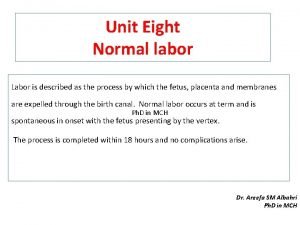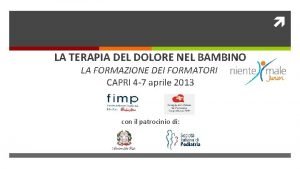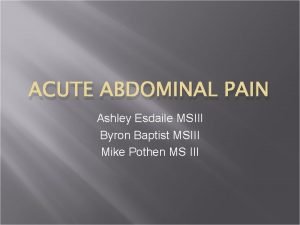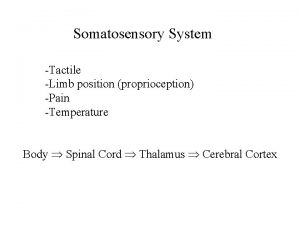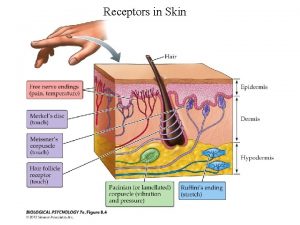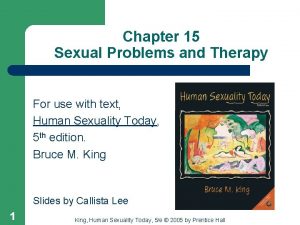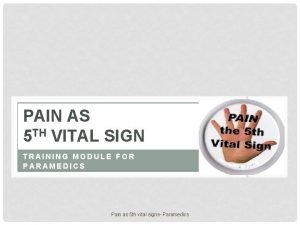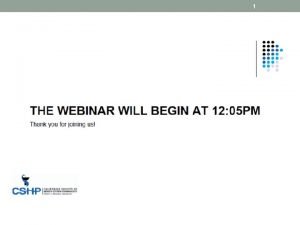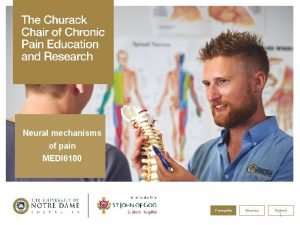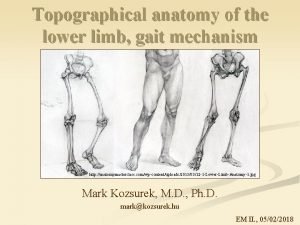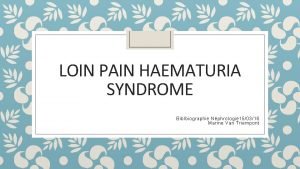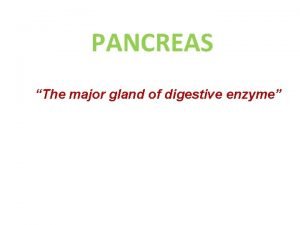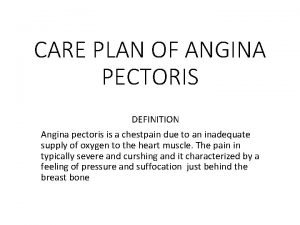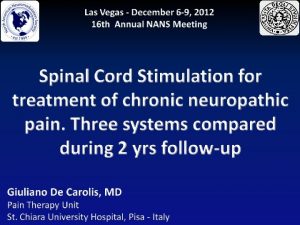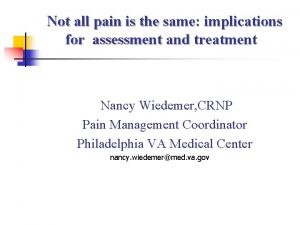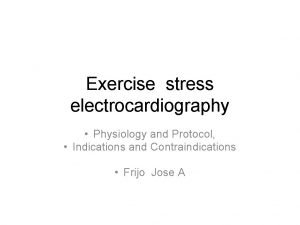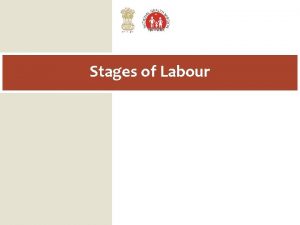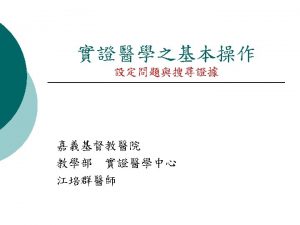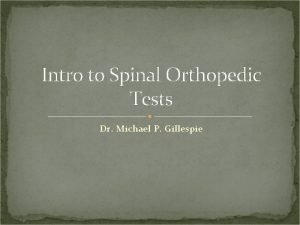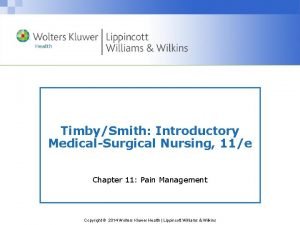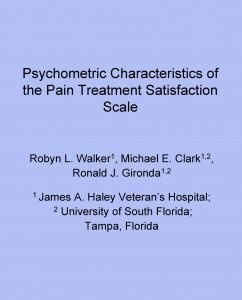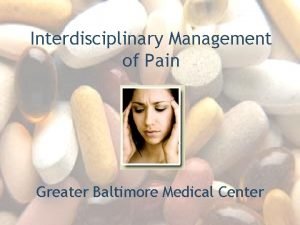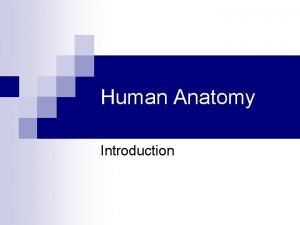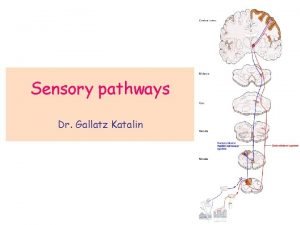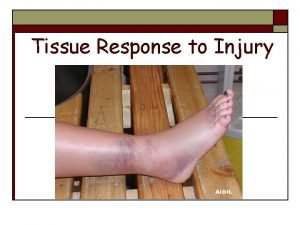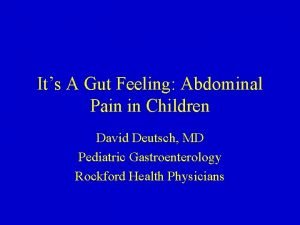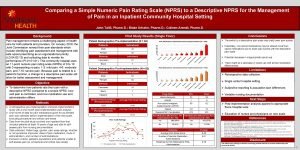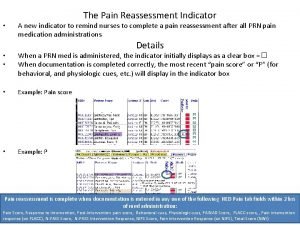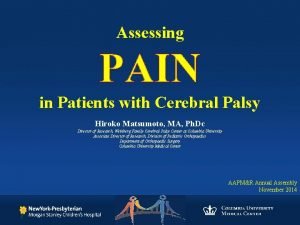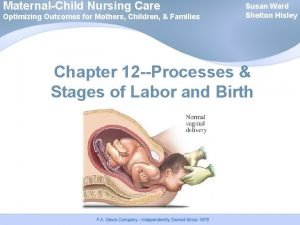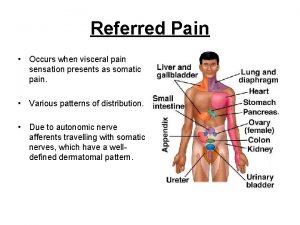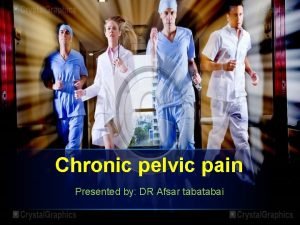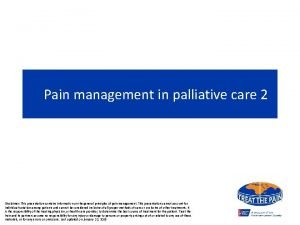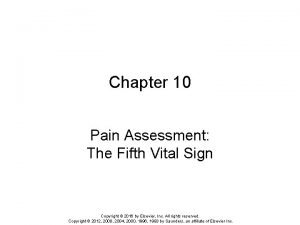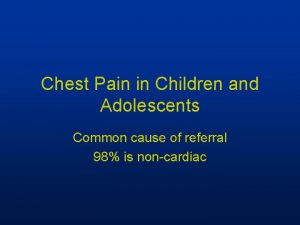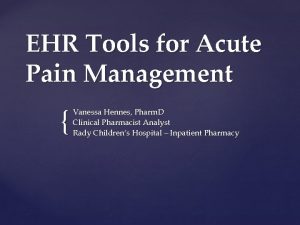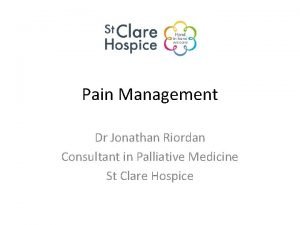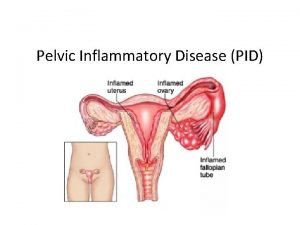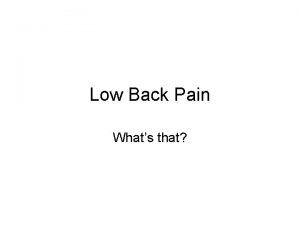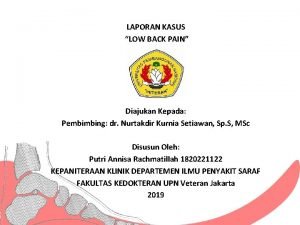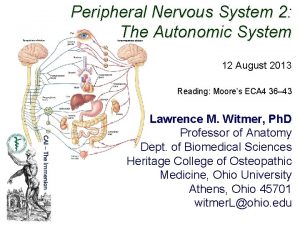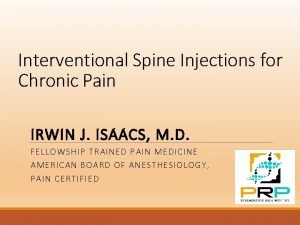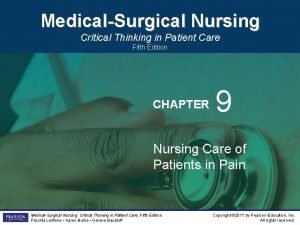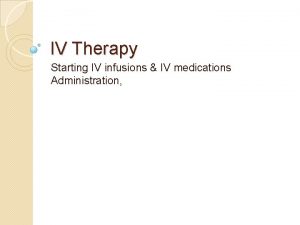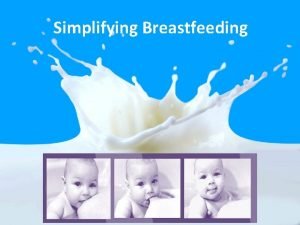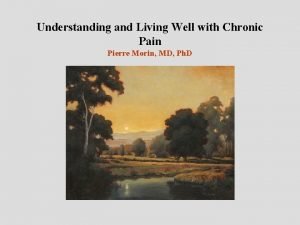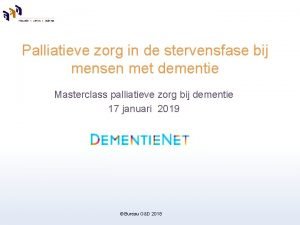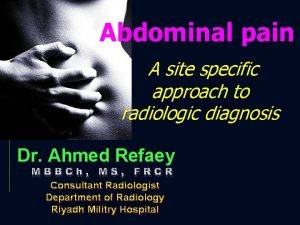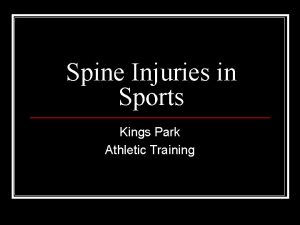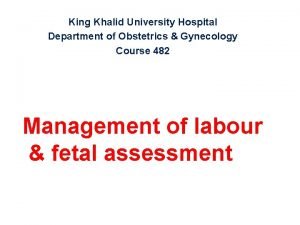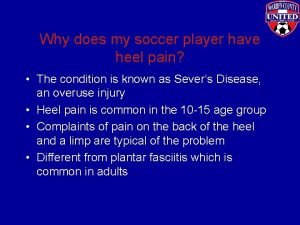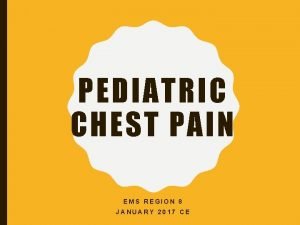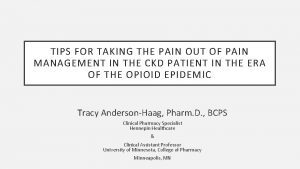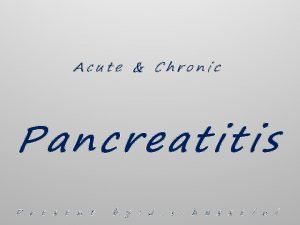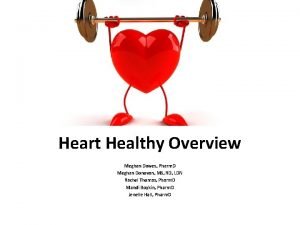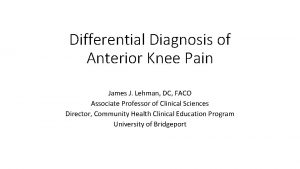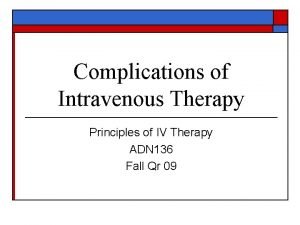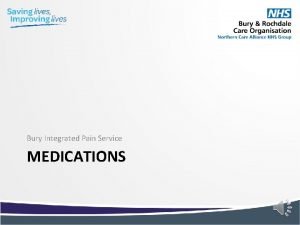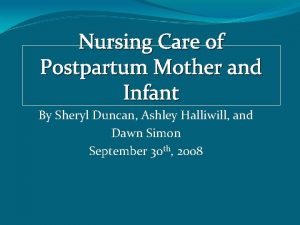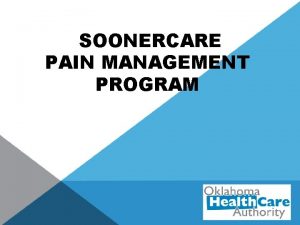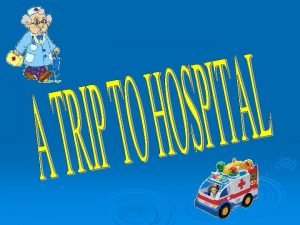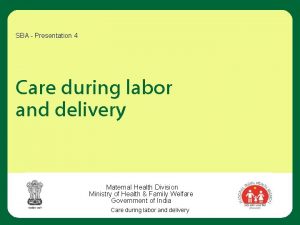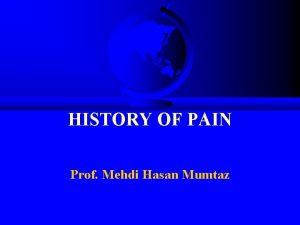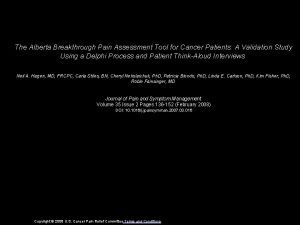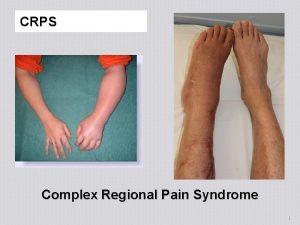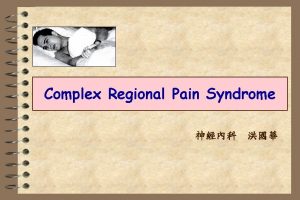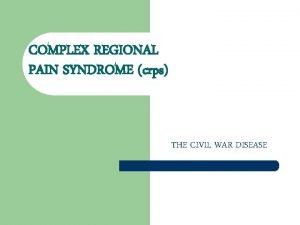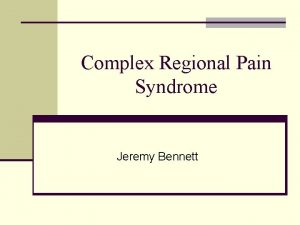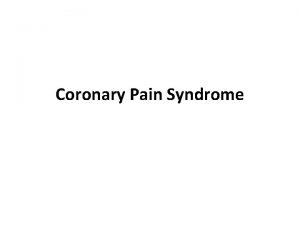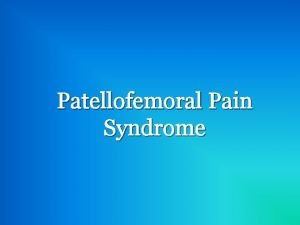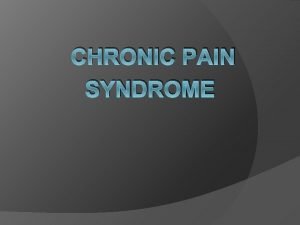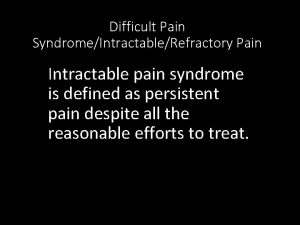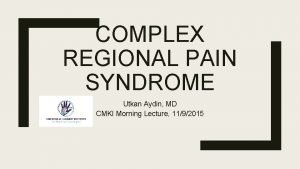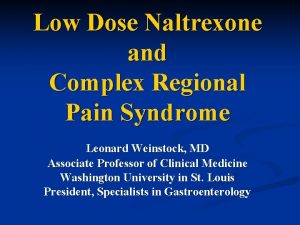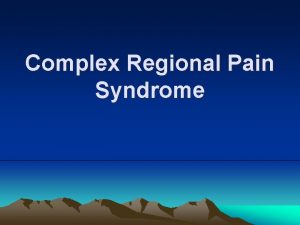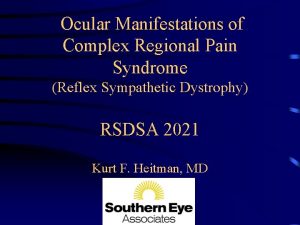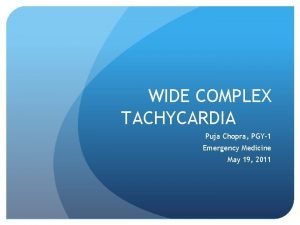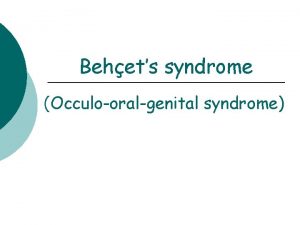Complex Regional Pain Syndrome CRPS Pradeep Chopra MD







































































































































- Slides: 135

Complex Regional Pain Syndrome (CRPS) Pradeep Chopra, MD Assistant Professor (Clinical) The Warren Alpert Medical School of Brown University USA snapa 102@gmail. com

Disclosure and disclaimer • I have no actual or potential conflict of financial interest in relation to this presentation or program • This presentation will discuss “off-label” uses of medications • Discussions in this presentation are for a general information purposes only. Please discuss with your physician your own particular treatment. This presentation or discussion is NOT meant to take the place of your doctor. Pradeep Chopra, MD

Disclosure • Pain Medicine specialist • Assistant Professor – Brown Medical School, Rhode Island, USA • Training and Fellowship, Harvard Medical school Pradeep Chopra, MD 3

How do you know if you have CRPS? Pradeep Chopra, MD

Signs and Symptoms of CRPS • Pain starts in one limb • It can present in the trunk (spine, abdomen, chest wall, pelvis) • Constant pain, even at rest with intermittent exacerbations. • Temperature difference between two sides • Color difference – comes and goes • Swelling – comes and goes • Area of pain larger than the primary injury Pradeep Chopra, MD 5

Early and chronic stages • The temperature difference is much more obvious in the early stages but as it becomes chronic, the difference may not be as obvious • The color difference is much more obvious in the early stages • Swelling is random and does not imply severity of the condition. Pradeep Chopra, MD 6

Signs and Symptoms of CRPS • Pain or uncomfortable sensation to touch • Nail growth changes (faster, distorted), • hair growth changes (coarser, darker, rapid growth, hair falling), • skin changes – thin and shiny • skin lesions – pin point lesions to blisters • Increased sweating Pradeep Chopra, MD 7

Color difference Pradeep Chopra, MD 8

Hair growth Pradeep Chopra, MD 9

Swelling Color change Pradeep Chopra, MD 10

Swelling Nails growth faster, brittle, ridged Pradeep Chopra, MD 11

Swelling Color change Pradeep Chopra, MD 12

Tests that are not helpful for diagnosing CRPS • Imaging techniques – x-ray, MRI, f. MRI, Three phase bone scan, bone density • Blood tests • Skin biopsy • Sympathetic nerve tests – sweat test, sympathetic skin response, • Nerve tests – EMG, nerve conduction, • The tests MAYBE used if another diagnosis is suspected. Atkins RM, Tindale W, Bickerstaff D, Kanis JA. Quantitative bone scintigraphy in reflex sympathetic dystrophy. Br J Rheumatol 1993; 32(1): 41 -5. Todorovic-Tirnanic M, Obradovic V, Han R, Goldner B, Stankovic D, Sekulic D, et al. Diagnostic approach to reflex sympathetic Pradeep Chopra, MD dystrophy after fracture: radiography or bone scintigraphy? Eur J Nucl Med 13

• Thermography (Thermal imaging) is helpful

CRPS in children Pradeep Chopra, MD 15

Children and RSD • Children develop the same symptoms • 58% to 93% of cases of CRPS in children will resolve with proper treatment Pradeep Chopra, MD 16

CRPS in children • The pain is no different from adults • The symptoms such as color change, temperature change, are the same as in adults • Yet, children are treated very differently than adults. • The treatment in children is based on extensive (boot camp) exercise with very little attention paid to managing pain • In adults, the focus is mostly on managing pain first before exercise.

Connective tissue disorders in children • Children may present with undiagnosed connective tissue disorder • Our entire body is held together with tissue e. g. ligaments, muscles, tendons - Connective tissue • In some children and young adults this connective tissue is weak. • They often present with nerve pain and CRPS

Connective tissue disorders in children • A common type of connective tissue disorder in children is Ehlers Danlos Syndrome (EDS). • They have loose joints • Soft velvety skin • Can often do “party tricks” with their body

Connective tissue disorders in children They may have: • Headaches • Body wide pain, • Belly pain • Sensitive to foods, medicines • Lots of ‘allergies’ • Fatigue • Poor sleep

Psychiatric misdiagnosis • The diagnosis of Conversion Disorder or Munchausen by Proxy are often made by providers with little training in Psychiatry and vice versa most psychiatrists have no training in pain conditions. • Parents – please research the facility or doctor carefully before taking your child there. Pradeep Chopra, MD 22

Psychiatric misdiagnosis • The facility should have experienced physicians in CRPS and its complications • There are some hospitals that have hired “Medical Child Abuse” specialists – stay away from them Pradeep Chopra, MD 23

Misdiagnosis • Please check with other patients to get feedback before you go to a hospital. • If you sense that the doctors are skeptical of your complaints, consider going somewhere else. Pradeep Chopra, MD 25

Misdiagnosis • When you go to an a academic hospital, chances are that you will be seen by a junior doctor / Resident – who is the least qualified to manage complex medical conditions. • Avoid hospitals that have employed “Child Abuse Physicians” • If you are able, choose a Concierge physician or Personalized Medicine Pradeep Chopra, MD 26

Children and RSD • CRPS in children is often associated with other conditions such as • Ehler’s Danlos Syndrome (EDS) • Mitochondrial disorder • Nerve entrapment Pradeep Chopra, MD 27

Management Complex Regional Pain Syndrome (CRPS) Reflex Sympathetic Dystrophy (RSD) Pradeep Chopra, MD 28

Basic guidelines in treating CRPS • Start treatment immediately, even if you suspect CRPS • Must be evaluated by a physician who is very familiar with it, to start appropriate therapy • Physicians treating CRPS must have a well rounded approach. Not focused on one modality e. g. ketamine or Spinal cord stimulators only Pradeep Chopra, MD 29

Management of CRPS – step A • The first step to do is to confirm if it is CRPS. • Very often patients are told that it is CRPS because a cause of the pain could not be found • The criteria for diagnosis of CRPS very specific Pradeep Chopra, MD 30

Management of CRPS – step B • The next thing to do is to determine if its CRPS I or CRPS II • CRPS II is more common than CRPS I • Unfortunately, most patients get labelled as CRPS I Pradeep Chopra, MD 31

CRPS I and CRPS II • In CRPS I – we do not know the exact nerve that is damaged • In CRPS II – limited to a specific nerve distribution • Some of the treatments are common to both • CRPS II usually has a more definitive treatment Pradeep Chopra, MD 32

CRPS-NOS (not otherwise specified) • CRPS-NOS (not otherwise specified): partially meets CRPS criteria; • Not better explained by any other condition. Usually used for patients who had CRPS but now present with some features and do not meet all the criteria. Pradeep Chopra, MD 33

Management of CRPS – possible causes of CRPS I • Unknown • Autoimmune dysfunction • Gastrointestinal • Mitochondrial dysfunction Pradeep Chopra, MD 34

CRPS II This was the first CRPS discovered, even before CRPS I Pradeep Chopra, MD 35

CRPS II • Most of the symptoms are similar to CRPS I • There is a major nerve damage that can be identified • A careful examination may identify the nerve affected Pradeep Chopra, MD 36

Some examples of CRPS II • Arms – Thoracic outlet syndrome, ulnar nerve entrapment • Legs – Common Peroneal neuralgia, • Scarring after a nerve injury. • Ehlers Danlos Syndromes – diffuse neuroinflammation from recurrent subluxations and dislocations. Pradeep Chopra, MD 37

Pain patterns in Thoracic Outlet syndrome 38

Thoracic Outlet Syndrome Pradeep Chopra, MD 39

An example of CRPS II in the leg • Symptoms of CRPS II may develop in the leg after impingement of the Common Peroneal nerve • This nerve lives below and just outside the knee Pradeep Chopra, MD 40

CRPS II in the leg – affecting the Peroneal nerve Pain in leg and top of foot Foot drop – difficulty raising foot Tend to trip on their toes

Ketamine Pradeep Chopra, MD 42

Central Sensitization (CRPS) • Two things happen in Central Sensitization: 1. Glial cells are activated 2. NMDA receptors are activated Pradeep Chopra, MD 43

Central Sensitization (CRPS) • Two things happen in Central Sensitization: 1. Glial cells are activated 2. NMDA receptors are activated Pradeep Chopra, MD 44

Central Sensitization - NMDA receptors • In CRPS there is activation and proliferation of NMDA receptors Activation of the NMDA receptors makes the Central Nervous system sensitive to pain and decreases sensitivity to opioids Milligan ED, Watkins LR (2009) Pathological and protective roles of glia in chronic pain. Nat Rev Neurosci 10: 23– 36 Pradeep Chopra, MD 45

Ketamine • Ketamine is a good NMDA Receptor blocker • One of the safest anesthetic drugs • Powerful analgesic even at low doses • Poor absorption when administered orally. • Effective as IV or sublingual (Troche) or nasal Correll GE, Maleki J, Gracely EJ, Muir JJ, Harbut RE. Subanesthestic ketamine infusion therapy: a retrospective Pradeep Chopra, MD analysis of a novel therapeutic approach to complex regional pain syndrome. Pain Medicine 2004; 5(3): 263 -75. 46

Ketamine infusion – good news • FDA is considering approving Ketamine infusions for the treatment of depression • Once it gets approved, it should be covered by insurance • More and more centers are now offering ketamine infusions Pradeep Chopra, MD 47

Tip on choosing a center that offers ketamine infusion for CRPS • Ketamine infusions are good only if done in conjunction with otherapies Pradeep Chopra, MD 48

Ketamine – out patient • Increasing dose of ketamine over 10 days – loading dose • Start at a low dose, increase everyday • Infusion done over 4 to 5 hours • Full standard monitoring • Qualified personnel must be present at all times with the patient Pradeep Chopra, MD 50

IV Ketamine - boosters • Very important part of the treatment protocol • As the effect of the initial ketamine wears off, the glial cells begin to get activated again. • Boosters for one day or two days every 4 to 8 weeks depending on the severity, chronicity and response • The protocol has to be customized to each patient Pradeep Chopra, MD 51

Ketamine side effects • Most of the side effects are temporary and short lived and reversible. • We do not know of any long term side effects of ketamine infusions. • Temporary side effects: Nausea, vomiting, colorful dreams, hallucinations, headache Pradeep Chopra, MD 52

Ketamine oral • Oral ketamine – don’t bother • Unpredictable effects Pradeep Chopra, MD 53

Dose of IV ketamine • Low doses • Each person has their own effective dose • Most physicians have found good results with 200 mg to 300 mg over 4 hours. • The dose can be reduced after some time.

Low Dose Naltrexone LDN

Low Dose Naltrexone (LDN) • Competitive antagonist of opioid receptors • Clinically used for 30 years for heroin and alcohol addiction • Suppresses glial cell activation, which…. • Attenuates production of pro-inflammatory cytokines and neurotoxic superoxides (chemicals that cause inflammation) Pradeep Chopra, MD

Low Dose Naltrexone (LDN) • There are several theories as to how LDN may work. 1. Transiently blocks opioid receptor leading to positive feedback production of endorphins (Zagnon) 2. LDN increases production of OGF (opioid growth factor) as well as number of and density of OGF receptors by intermittently blocking the opiate receptor. Increased in OGF repairs tissue and healing. 3. Naltrexone blocks the effect of TLR 4 (Toll Like receptors) which decreases glial cell activation

Low Dose Naltrexone (LDN) • There are several theories as to how LDN may work. 1. Transiently blocks opioid receptor leading to positive feedback production of endorphins 2. LDN increases production of OGF (opioid growth factor) as well as number of and density of OGF receptors by intermittently blocking the opiate receptor. Increased in OGF repairs tissue and healing. 3. Naltrexone blocks the effect of TLR 4 (Toll Like receptors) which decreases glial cell activation

Low Dose Naltrexone (LDN) • Dose can vary anywhere between 1. 75 mg to 4. 5 mg • May cause insomnia, mild headaches initially. • Patients report increased physical activity, flare ups not as acute, better tolerance to pain. • Recommend a trial of at least 6 months • To avoid all opioids or tramadol. • Has to be made by a compounding pharmacy • Inexpensive Pradeep Chopra, MD

Low Dose Naltrexone (LDN) • LDN Research Trust • This website has more information on LDN Pradeep Chopra, MD

Sensory Deprivation Therapy • Isolation tank. • Warm water with high quantities of EPSOM salt • Subject floats on the water because of the high salt content • No lights or sounds in the room • All external stimulation to the Central Nervous system (brain and spinal cord) is cut off. • Very helpful for Central Sensitization Pradeep Chopra, MD

Treatments that are usually not helpful

Spinal Cord Stimulator (SCS) • An electrode is inserted surgically into the epidural space and connected to an implanted generator • The electrode produces an electrical current is felt as a tingling sensation and suppresses pain. • Mechanism of action unknown • Painful and expensive • No great benefit after sometime • Dorsal root ganglion stimulator - new Kemler MA, Barendse GA, Kleef M van, Vet HC de, Rijks CP, Furnee CA, et al. Spinal cord stimulation in patients with chronic reflex sympathetic dystrophy. N Engl J Med 2000; 343(9): 618 -24. Bennett DS, Alo KM, Oakley J, Feler CA. Spinal cord stimulation for complex regional pain syndrome I (RSD): a retrospective multicenter Pradeep Chopra, MD experience from 1995 to 1998 of 101 patients. Neuromodulation 1999; 2: 202 -10. 65

Spinal Cord Stimulator (SCS) • 25% to 50% of patients develop complications requiring further surgery. • In a huge study SCS reduced pain and improved quality of life but did not improve function for up to 2 years after implantation. • From 3 years after implantation there was no difference between those who had it implanted and those who did not Kemler MA, Barendse GA, Kleef M van, Wildenberg FA van den, Weber WE. Electrical spinal cord stimulation in reflex sympathetic dystrophy: retrospective analysis of 23 patients. J Neurosurg 1999; 90(1 suppl): 79 -83. Calvillo O, Racz G, Didie J, Smith K. Neuroaugmentation in the treatment of complex regional pain syndrome of the upper extremity. Acta Orthop Belg 1998; 64(1): 57 -63. Kemler MA, Vet HC de, Barendse GA, Wildenberg FA van den, Kleef M van. The effect of spinal cord stimulation in patients with chronic reflex sympathetic Pradeep Chopra, MD dystrophy: two years’ follow-up of the randomized controlled trial. Ann Neurol 2004; 55(1): 13 -8. 66

Spinal Cord stimulator Pradeep Chopra, MD 67

Nerve Blocks for CRPS • Not helpful • Risky • Temporary (few hours to a day) at best

Nerves to the body Central nervous system (Brain and Spinal cord)

Nerves to the body Central nervous system (Brain and Spinal cord)

Nerves to the body Central nervous system (Brain and Spinal cord)

• The source of inflammation is in the brain, not the nerve

Desensitization – very bad idea • Rice bowl, rubbing with a piece of cloth, paraffin bath, etc. • Desensitization exercises have been recommended for a long time for CRPS • The idea of desensitization came from treating mental conditions such as phobias • Pain is CRPS is real pain, not a mental condition • Worsens Central Sensitization, harmful for CRPS Pradeep Chopra, MD 73

CRPS and Physiotherapy in Children • Some centers force children to undergo severe physical therapy without controlling their pain first. • If the child does not improve, doctors blame it on the child’s mental condition or the parents who advocate for them • This approach has left long term psychological trauma on these children • The same standards are not applied to adults Pradeep Chopra, MD 74

Caution • If someone calls it Amplified Pain Syndrome • There is no such thing as Amplified pain syndrome, the person is implying that it is ‘all in your head’ • Nerve blocks • Spinal cord stimulators, especially if that is the first and only thing they offer • Psychiatrist – if that is the main treatment offered. • You are diagnosed with CRPS within minutes of being seen and no detailed examination of the affected area Pradeep Chopra, MD 75

Gastrointestinal system and CRPS How our foods may affect our pain Pradeep Chopra, MD 76

Gastrointestinal system (GI system) and CRPS • In CRPS the diversity of bacteria is less (normally, approximately 1000 different types of bacteria) • This causes GI inflammation, the lining of the intestines is damaged, and increased production of pro-inflammatory cytokines (chemicals that trigger pain) Erin R. Reichenberger a, Guillermo M. Alexander b, Marielle J. Perreault b, Jacob A. Russell c, Robert J. Schwartzman b, Uri Hershberg a, 1, Gail Rosen. Establishing a relationship between bacteria in the Pradeep Chopra, MD human gut and Complex Regional Pain Syndrome. Brain, Behavior, and Immunity 29 (2013) 62– 69 77

Gastrointestinal system (GI system) and CRPS • TLR 4 receptor activity is increased. This has been associated with inflammation. • TLR 4 is one of the receptors where LDN works. Erin R. Reichenberger a, Guillermo M. Alexander b, Marielle J. Perreault b, Jacob A. Russell c, Robert J. Schwartzman b, Uri Hershberg a, 1, Gail Rosen. Establishing a relationship between bacteria in the Pradeep Chopra, MD human gut and Complex Regional Pain Syndrome. Brain, Behavior, and Immunity 29 (2013) 62– 69 78

Gastrointestinal system (GI system) and CRPS • These nerves are directly stimulated by the bacteria to develop an immune response and release of cytokines. Collins and Bercik, 2009; Mac. Donald and Monteleone, 2005; Round and Mazmanian, 2009). Pradeep Chopra, MD 81

Small Intestinal Bacterial Overgrowth (SIBO) • Overgrowth of bacteria in the small intestine causes an inflammatory response in the intestine. • SIBO – Small Intestine Bacterial Overgrowth – talk to Gastroenterologist • Bloating, abdominal pain, fatigue, weakness, • Autoimmune dysfunction, CRPS • The test for SIBO is an easy breath test. Pradeep Chopra, MD 82

Median Arcuate Ligament Syndrome MALS Pradeep Chopra, MD 83

Abdominal pain – Median Arcuate Ligament Syndrome (MALS) • Belly pain after eating food. • Bloating • Certain postures make pain worse or better • Pain in upper part of abdomen Pradeep Chopra, MD 84

Abdominal pain – MALS • There is an artery that supplies blood to part of the intestine • It is called Celiac Artery • There is a nerve in that area called Celiac ganglion which may be getting compressed or inflamed. Pradeep Chopra, MD 85

Abdominal pain – MALS • Treatment is surgical removal of the nerve (celiac ganglion) • If treated early, symptoms resolve Pradeep Chopra, MD 87

Neridronate • Initial results of trials done in USA have not been successful • Italian study had 100% improvement - ? ? • Zolodronic acid (similar drug) failed trials in UK Varenna M, Adami S, Rossini M. Treatment of CRPS I with neridronate: a randomized, double blind, pacebo controlled study. Rheumatology. Doi 110. 1093/rheumatology/kes 312 274, 299 Pradeep Chopra, MD 89

Vitamin D • Vitamin D promotes Calcium absorption in the gut • Helps bone development • Helps muscle and immune function • Reduces inflammation Pradeep Chopra, MD 90

FREE RADICAL SCAVENGERS Antioxidants Pradeep Chopra, MD 91

Free radicals • The increased sympathetic nerve activity in the area cause blood vessels to constrict, hence the cold, pale limb. • Reduced blood flow, tissue damage and increased acid production • This causes increased production of free radicals which increase pain in the area. Pradeep Chopra, MD 93

Free Radical scavengers (Antioxidants) • Alpha Lipoic Acid • Vitamin C • DMSO (Dimethyl sulphoxide) – cream or lotion • N-Acetyl Cysteine (NAC) • They are available over the counter Pradeep Chopra, MD 95

Alpha Lipoic acid (ALA) • Free Radical scavenger (antioxidant) • Promising results in diabetic neuropathy and other polyneuropathies • No trials in CRPS • Has been approved in Germany for treating neuropathic pain • Dose: 600 mg to 1200 mg per day • Start low, go slow Kapoor S, Foot Ankle Spec, 2012 Aug; 5(4); 228 -9 Snedecor SJ, Sudarshan L, Cappelleru JC etc al. 2013 Pain Pract, Mar 28 Pradeep Chopra, MD 96

Vitamin C • Natural antioxidant • There are several studies that have shown that Vitamin C can prevent CRPS after a fracture • Vitamin C 500 mg was shown to prevent development of CRPS • Vitamin C 500 mg/day may help in patients who have developed CRPS • No value to going higher than 500 mg / day Zollinger Paul, Tuinebereijer, Keir R, Breederveld, 1999, Lancet Jae Hun Kim 1, Yong Chul Kim 2 International Journal of Medical Sciences Pradeep Chopra, MD 2017; 14(1): 97 -101. doi: 10. 7150/ijms. 17681 98

N- Acetyl Cysteine (NAC) • Useful for cold pain • N-Acetylcysteine 600 mg three times a day for three months • Start low, go slow Perez RS, Zuurmond WW, Bezemer PD, Kuik DJ, Loenen AC van, Lange JJ de, et al. The treatment of complex regional pain syndrome type I with free radical scavengers: a randomized controlled study. Pain 2003; 102(3): 297 -307 Pradeep Chopra, MD 99

Oxytocin • Chemical produced naturally in the brain • Taken as a nasal spray, sublingual • Especially helpful in flare ups (acute pain) • Two mechanisms by which oxytocin reduces pain • Directly on the spinal cord to turn down pain signals • By releasing endorphins (morphine produced by the body). Pradeep Chopra, MD Rash JA, et al Oytocin and Pain. Clin J Pain 2014; 30 -453 -462 100

Calcitonin Related Gene Peptide (CGRP) • Higher levels of CGRP found in CRPS and pain conditions in most patients especially in early stages • Recently released CGRP antibody and CGRP receptor antagonists have been approved for treatment of migraines. • Low side effects. • Too early to say if they will help CRPS and chronic pain

Calcitonin Related Gene Peptide (CGRP) • Erenumab-aooe (Aimovig™) – injection • Fremanezumab (Ajovy ™) • Galcanezumab (Emgality ™) • phase III trials • Atogepant – pill • Eptinezumab

Electrical stimulation • Different therapies available that involve electrical stimulation of nerves. • Very unhelpful • Try not to pass electricity through nerves that are already inflammed • May try a TENS unit. Pradeep Chopra, MD 104

Mechanism of pain in CRPS Two things happen after an injury 1. Facilitated inflammation 2. Cortical reorganization (Structural changes in the brain with increased pain)

Facilitated inflammation - Mechanism of pain in CRPS • Early stages, and during flare ups • Skin redness, warmth, swelling, increased nail growth, hair growth and sweating • Caused by release of Calcitonin gene-related peptide (CGRP) or substance P

Facilitated inflammation - Mechanism of pain in CRPS • Cells called Mast Cells are activated. Especially in the skin • Mast Cells release chemicals that sensitize the pain nerves in the skin • Drugs that stabilize Mast cells like Cromolyn and Quercetin may help.

Cortical reorganization - Mechanism of pain in CRPS • The brain is plastic (Neuroplasticity) • It changes and adapts depending on the signals going into the brain • When the brain is flooded with a barrage of pain signals, the structure of the brain changes to adapt to it. Li W-W, Guo T-Z, Liang D, Sun Y, Kingery WS, Clark JD: Substance P signaling controls mast cell activation, degranulation, and nociceptive sensitization in a rat fracture model of complex regional pain syndrome. ANESTHESIOLOGY 2012; 116: 882– 95.

Cortical reorganization - Mechanism of pain in CRPS • The changes in the brain is one of the reasons for muscle spasms (dystonia), pain to touch, tingling, and neglect-like symptoms. • To reverse these changes, one has to 1. Control pain 2. Move the limb (that is why control pain first and decrease the number of pain signals going to the brain) Li W-W, Guo T-Z, Liang D, Sun Y, Kingery WS, Clark JD: Substance P signaling controls mast cell activation, degranulation, and nociceptive sensitization in a rat fracture model of complex regional pain syndrome. ANESTHESIOLOGY 2012; 116: 882– 95.

Graded Motor Imagery

Three stages of Graded Motor Imagery delivered sequentially • Left / right discrimination • Explicit Motor imagery • Mirror therapy • www. gradedmotorimagery. com Neuro Orthopedic group, Australia

Stage 1: Left/Right discrimination – Graded Motor Imagery • In CRPS, people often lose the ability to identify left or right images of their painful body parts. • This ability is important for normal recovery from pain • The good news is that the brain is plastic and changeable. • The ‘Recognise’ app helps regain this ability Pradeep Chopra, MD 113

Stage 2: Explicit Motor Imagery - Graded Motor Imagery • The process of thinking about moving without actually moving • Imagined movement can actually be hard work if you are in pain. • 25% of our brain is made of ‘mirror neurons’ – they start firing when you think of moving or even watch someone else move • Imagining movements before actually moving you use the same neurons that you would use when you actually move www. gradedmotorimagery. com Neuro Orthopedic group, Australia 114

Pradeep Chopra, MD 115

Stage 3: Mirror therapy- Graded Motor Imagery • By hiding the affected limb behind a mirror, you can trick the brain into believing that the reflection of the normal hand is the affected limb. • In your brain you are exercising the affected limb as you move the normal limb. www. gradedmotorimagery. com Neuro Orthopedic group, Australia 116

Basal Ganglia • In CRPS – there is reduced dopamine • Levodopa (Sinemet™) can increase dopamine and may help movement disorders in CRPS Azqueta-Gavaldon et al. Basal ganglia dysfuntion in CRPS-a valid Hypothesis? European Journal of pain . 2016 Pradeep Chopra, MD Navani, Journal of Pain and Symptom management. 2003 118

Muscle dysfunction in CRPS • Significant muscle issues such a dystonia, tremors, persistent flexion postures of fingers and toes. • Dystonia is unrelated to Central sensitization and is unlikely to respond to ketamine • A trial of Sinemet may be helpful • EPSOM salt bath, Magnesium is helpful Pradeep Chopra, MD 119

Skin Lesions in CRPS – use ketamine ointment Pradeep Chopra, MD 124

Service Dogs • Help with functioning and independence • Constant companion, will often sense its owners pain and will comfort them both physically and emotionally • Can sense distress and call for help • Service dogs give patients a feeling of security allowing them to be more active physically and socially Pradeep Chopra, MD 125

Service Dogs - invaluable • They can sense when their owner is having an episode of dizziness or seizure • CRPS and pain - they protect the limb from being injured or touched • Helps boost confidence in their owners, making them more independent • Help with balance, call for help, open doors, switch on lights, pull wheelchairs, anxiety, Pradeep Chopra, MD 126

Surgery and Complex Regional Pain Syndrome (CRPS) Pradeep Chopra, MD 127

Surgical trauma and Complex Regional Pain Syndrome (CRPS) • Avoid surgery unless you have to • Start gabapentin or pregabalin 2 weeks before the surgery • Vitamin C 500 mg one daily. Start 7 days before surgery and continue for 45 days after surgery

Surgical trauma and CRPS - Intra – operative • Use intravenous ketamine as part of anesthesia • Apply topical numbing medicine over IV site before insertion of needle • IV must be inserted with minimum trauma (first shot, smallest needle possible) • Epidural or spinal anesthesia, if lower body surgery •

Surgical trauma and CRPS • Mark in record the area with CRPS that it should be handled with extreme care • Continue low dose IV ketamine in the recovery room for a few hours – very important • Continue epidural anesthesia for pain control, if inserted pre op, for at least 24 hours

Needle stick injuries • Minimize needle stick injuries as far as possible – combine a blood test from different physicians into one procedure • Ask that the thinnest needle possible be used. • Use a topical numbing cream (EMLA® or Synera® patch) • Let them know that your veins are ‘difficult’. CRPS patients have thin veins • Ask for the most experienced person to insert IV or blood draw • For those undergoing regular infusions (IV fluid rehydration or IV Ketamine) should consider a chest port • PICC line is not a good option

Hospital • Ask for a sign over the bed that the affected limb is not to be touched. • Avoid loud sounds, bright lights • Cage over the affected limb • Have a friend or family member to make sure that the area with CRPS is not touched Pradeep Chopra, MD 132

Palmitoyl ethanol amide (PEA)

PEA • Palmitoylethanolamide (PEA) or Palmidrol • Endogenous lipid • Very good studies to show its usefulness in managing neuropathic pain

PEA • Now available in USA • Comes as pills and ointment. • Place powder from capsule under the tongue for the first 10 days. • Ointment works well over small areas Pradeep Chopra, MD 136

CENTRAL SENSITIZATION Key concept to understanding CRPS Pradeep Chopra, MD

Central Sensitization • As the spinal cord and brain is flooded with a barrage of pain signals, the nerves in brain and spinal cord become hyper-sensitized Pradeep Chopra, MD 138

Central Sensitization • A normal sensation (e. g. touch) produces an abnormal response (like pain) because the brain and spinal cord are sensitized • Definition: Increase in the excitability of neurons within the central nervous system (CNS) so that normal inputs produce abnormal responses Pradeep Chopra, MD 139

Pradeep Chopra, MD 140

Pradeep Chopra, MD 141

Pradeep Chopra, MD

Pradeep Chopra, MD 143

Pradeep Chopra, MD 144

Pradeep Chopra, MD 145

Spreading • In long standing cases of CRPS, some patients develop similar symptoms in other areas of the body • This is usually a result of increasing Central Sensitization. • As the central nervous system become more and more sensitized, normal sensations to other parts of the body are felt as painful sensations. Pradeep Chopra, MD 146

Central Sensitization: Activated Glial Cells • Glial cells make up 70% of all the cells in our Central Nervous System • Under normal circumstances, they remain dormant and are part of the nervous system's immune function Pradeep Chopra, MD 149

Central Sensitization: Activated Glial Cells • In CRPS these glial cells are activated. • Activated glia release certain chemicals (Cytokines) that cause nerves to become inflamed • Glial cells are an important link between the nervous system and the immune system and inflammation and pain Milligan ED, Watkins LR (2009) Pathological and protective roles of glia in chronic pain. 150 Pradeep Chopra, MD Nat Rev Neurosci 10: 23– 36 150

Glia and nerves under normal conditions Pradeep Chopra, MD

Activated Glia Pradeep Chopra, MD

Chemicals released by activated Glia Pradeep Chopra, MD

Nerve inflammation Pradeep Chopra, MD

The problem is with the glia cells Pradeep Chopra, MD

Acknowledgments • Roxanne Dawn for all the hard work in putting this meeting together • CRPS Forum • www. crpsforum. com • Finding help for living with CRPS is a team effort, be more involved with others going through the same journey Pradeep Chopra, MD

Thank you Pradeep Chopra, MD snapa 102@gmail. com Pradeep Chopra, MD 157
 Dr chopra rhode island
Dr chopra rhode island Hva er crps
Hva er crps Pradeep kurukulasuriya
Pradeep kurukulasuriya Pradeep sharma university of houston
Pradeep sharma university of houston Dr pradeep tandon lakhimpur kheri
Dr pradeep tandon lakhimpur kheri Bob liang
Bob liang Prof. dr. pradeep kumar gupta
Prof. dr. pradeep kumar gupta Period cramps vs early pregnancy cramps
Period cramps vs early pregnancy cramps David lewis mad pain and martian pain
David lewis mad pain and martian pain Pain like periods in early pregnancy
Pain like periods in early pregnancy Ca amarjit chopra
Ca amarjit chopra Anuja changrani
Anuja changrani Prashant chopra sex offender
Prashant chopra sex offender Brijesh chopra
Brijesh chopra Anuj chopra rate my professor
Anuj chopra rate my professor Shreyans chopra
Shreyans chopra Riddhi chopra
Riddhi chopra Amit chopra md
Amit chopra md Aiesec tier 5
Aiesec tier 5 Supply chain management sunil chopra 6th edition ppt
Supply chain management sunil chopra 6th edition ppt Smriti
Smriti Simple compound complex and compound-complex sentences quiz
Simple compound complex and compound-complex sentences quiz Psychoanalytic and psychodynamic
Psychoanalytic and psychodynamic Ghon complex
Ghon complex Type a and type b personality theory
Type a and type b personality theory Simple compound complex sentences quiz
Simple compound complex sentences quiz The electra complex
The electra complex Myocardial infarction pain location
Myocardial infarction pain location Scapular dyskinesis
Scapular dyskinesis Nerves of abdominal wall
Nerves of abdominal wall Typical vs atypical chest pain
Typical vs atypical chest pain Entre nos mains tu es le pain
Entre nos mains tu es le pain Vasten sign
Vasten sign Nccpc pain scale
Nccpc pain scale Nociceptive pain
Nociceptive pain Megacolin
Megacolin Pain temperature proprioception
Pain temperature proprioception Oldcarts
Oldcarts Pain school international
Pain school international Pain receptors in brain
Pain receptors in brain Right upper quadrant pain
Right upper quadrant pain In a stressful situation feelings of pain are dulled by
In a stressful situation feelings of pain are dulled by Sexual pain
Sexual pain Pain scale ruler kkm
Pain scale ruler kkm Pqrstu pain assessment
Pqrstu pain assessment Total pain
Total pain Ceo pain
Ceo pain Pain goals
Pain goals Pico question example
Pico question example Pain pathway diagram
Pain pathway diagram Gait support
Gait support True labour pain definition
True labour pain definition Loin pain
Loin pain Posterior abdominal wall nerves
Posterior abdominal wall nerves Le grillardin menu
Le grillardin menu Stable angina nursing diagnosis
Stable angina nursing diagnosis Twisting vibration
Twisting vibration Pisa university hospital
Pisa university hospital Nociceptive pain
Nociceptive pain Typical chest pain
Typical chest pain True labour pains
True labour pains Picos question
Picos question Schepelmann test positive
Schepelmann test positive Discogenic low back pain
Discogenic low back pain Jarvis chapter 11 pain assessment
Jarvis chapter 11 pain assessment Pain treatment satisfaction scale
Pain treatment satisfaction scale Pain pathway spinal cord
Pain pathway spinal cord Gbmc pain management
Gbmc pain management Stomach pain chart
Stomach pain chart Joel packer
Joel packer Pqrstu pain assessment
Pqrstu pain assessment Their pain your voice
Their pain your voice Through labor pain
Through labor pain Spinothalamic tract
Spinothalamic tract Cardinal signs of inflammation
Cardinal signs of inflammation What is pain jeopardy
What is pain jeopardy Causes of abdominal pain in children
Causes of abdominal pain in children Total pain
Total pain Rurethra
Rurethra Nprs pain scale
Nprs pain scale Opqrst
Opqrst Pain reassessment after intervention
Pain reassessment after intervention Non verbal pain scale pdf
Non verbal pain scale pdf Fetal head
Fetal head Prostate referred pain
Prostate referred pain Subcostalis
Subcostalis Pelvic girdle pain
Pelvic girdle pain Total pain
Total pain Brief pain inventory
Brief pain inventory Chest pain in pediatrics
Chest pain in pediatrics Pain management ehr
Pain management ehr Jonathan riordan
Jonathan riordan Par ton corps tu nous donnes la vie
Par ton corps tu nous donnes la vie Pelvic inflammatory disease
Pelvic inflammatory disease Sclerotogenous pain patterns
Sclerotogenous pain patterns Nociceptive pain
Nociceptive pain Sensitization
Sensitization Searing loss
Searing loss Laporan kasus ischialgia
Laporan kasus ischialgia Definition of pain
Definition of pain Romeo and juliet act ii quiz
Romeo and juliet act ii quiz Referred pain
Referred pain Lumbar referral patterns
Lumbar referral patterns Most painful diseases
Most painful diseases Translational research institute on pain in later life
Translational research institute on pain in later life Iv site pain and swelling
Iv site pain and swelling Ms pain points
Ms pain points Referred pain from appendicitis
Referred pain from appendicitis Nipple pain
Nipple pain Referred pain definition
Referred pain definition Pncreas pain
Pncreas pain Painad schaal
Painad schaal Divericulitis
Divericulitis Who is in charge when spine boarding an athlete and why
Who is in charge when spine boarding an athlete and why Chronic pain comorbidities
Chronic pain comorbidities True labour pains
True labour pains Heel pain soccer
Heel pain soccer Ruben gonzalez pain management
Ruben gonzalez pain management Chest pain in pediatrics
Chest pain in pediatrics Henrietta arch pain
Henrietta arch pain Types of pain
Types of pain Test for chronic pancreatitis
Test for chronic pancreatitis Diltiziam
Diltiziam Pncreas pain
Pncreas pain Patella dislocation
Patella dislocation Phlebitis vs infiltration vs extravasation
Phlebitis vs infiltration vs extravasation Bury integrated pain service
Bury integrated pain service Postpartum stomach pain
Postpartum stomach pain Soonercare pain management doctors
Soonercare pain management doctors Pain management synonym
Pain management synonym Marche du pain et des roses
Marche du pain et des roses True labour pains
True labour pains Pain
Pain Dr. mehdi pain management
Dr. mehdi pain management Epigastric pain differential diagnosis
Epigastric pain differential diagnosis Breakthrough cancer pain
Breakthrough cancer pain
